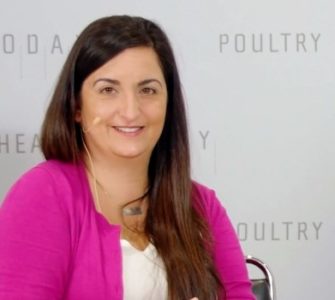Genomic technology sheds light on Salmonella serotypes in breeder flocks
A technology called CRISPR-SeroSeq, which amplifies a section of the Salmonella genome, is helping paint a clearer picture of the serotypes circulating in breeder flocks. The knowledge gained may help poultry producers design more targeted control measures.
“CRISPR” (pronounced “crisper”) stands for clustered regularly interspaced short palindromic repeats, according to the Broad Institute in Cambridge, Massachusetts. “CRISPR is the hallmark of a bacterial defense system that forms the basis for CRISPR-Cas9 genome editing technology,” the institute noted. Later, it was discovered that serotype-specific CRISPR patterns could be used for population analyses. The technique is called “CRISPR-SeroSeq” (serotyping by sequencing CRISPR).
Using CRISPR-SeroSeq, a polymerase chain reaction-based approach was developed by a team of researchers at the University of Georgia led by Nikki Shariat, PhD. The team analyzed 324 boot-sack samples from Southeastern breeder flocks, highlighting a mix of 35 different serotypes.
Although Salmonella Kentucky was the most commonly identified, the in-depth analysis revealed several serotypes associated with foodborne illness, such as Enteritidis, Infantis, Typhimurium and Braenderup.
“By more deeply analyzing the serotypes that are present, we hope that [we can] predict serotypes as they begin to emerge in poultry, to develop Salmonella-control strategies for those specific serotypes,” Shariat told Poultry Health Today.
Live production, processing differences revealed
A further aspect of the team’s work has been comparing the USDA’s Food Safety and Inspection Service (FSIS) data collected from processing facilities to those from live production in Georgia.
Whereas around 90% of serotypes found in live production were Salmonella Kentucky, serotypes associated with illness in humans have a much higher presence proportionally in the FSIS findings.
“[We think] Salmonella Kentucky is a serotype that’s better adapted to survive…perhaps by the time those broilers are being processed, the Kentucky is knocked down. It’s eliminated more effectively using those interventions in the plant compared to other serotypes, and that’s when you start to see these other serotypes occur,” Shariat said.
Deeper analysis paints full picture
Interest in CRISPR-SeroSeq has “really taken off,” she noted, with a growing realization among producers in various food systems that Salmonella often occurs in mixed populations.
Those serotypes that are an illness risk often present as minority or background serotypes, she continued, noting that traditional culture-based approaches are unlikely to provide high enough resolution to detect them. The genomic approach could also assist regulators in potentially designing serotype-specific control strategies.
“If the traditional methodology is only letting you identify Kentucky and not letting you see any deeper than that, then that limits the types of controls you can employ,” she added.
Posted on August 4, 2022














